Book Reviews
By-Susan Sharma
Ranthambore Adventure by Deepak Dalal
Vikram and Aditya's adventures, "Ranthambore Adventure" is a book targeted at teenagers, I was told. But when I started reading "Ranthambore Adventures", it was the most 'un-put-downable' book I had read in a long time. One could travel through Ranthambore,
through the visual writings of Deepak, reliving many wonderful experiences I had during my many visits there.
"When Aditya attempts to lay his hands on the diary of a ruthless tiger poacher, little does he know the events his actions will trigger. His ill-fated endeavour plunges Vikram and Aarti into a thrilling adventure that climaxes at the magnificent game park
of Ranthambore.
‘Ranthambore Adventure’ also narrates the story of the tiger, Genghis. Brimming with tiger-lore, it traces the moments of Genghis’s life – from his birth as a fluffy, helpless ball of fur, to his emergence as a proud and powerful predator. But vicious, greedy
humans infiltrate his kingdom, seeking his skin and his bones…
In Deepak's own words
"Animals and birds are doubtless the main draw of a forest, but there is more. No forest experience is complete without absorbing the peace and tranquility of a wilderness area. Imagine the absence of the rumble of traffic, of the bustle of humanity, of the
drone of engines and motors that run our world. Take in instead the rustle of the wind through the trees, the call of birds and animals, and the serenity of a forest. Understand what primal human beings enjoyed and what cities and civilisation have robbed
us of – the grandeur of nature."
Order this book online at
http://www.wildscapes.net/product-details.aspx?prdId=39
|
Green Defenders
Steel trap seized by forest department
By-Prajakta Hushangabadkar
A jackal was trapped in a steel trap and the animal was seen moving with it in the open scrub forest near Loni village on Amravati-Akola highway. The location is close to Karanja Sohol sanctuary.
Amit, a wildlife lover, was passing by on the way to his office when he saw the jackal with a steel trap lying in the middle of the road. Amazed at the jackal, Amit got into action. It helped that he was a volunteer with NCSA (Nature Conservation
Society, Amravati). He managed removing the trap as the jackal was still. He informed the forest officers. Mohan Jha, chief conservator of forest (CCF)for Amravati Circle, sounded a red alert in Amravati and Akola forest divisions. The RFO along with wildlife
activist Vishal Bansod were sent for investigation.
Jackal was found dead and the post mortem report said he died due to starvation. As he was injured and incapacitated by the trap, he could not hunt for food anymore.
Steel trap or 'bahelia trap' is used by the bahelia tribes for hunting. Bahelia tribals are basically from Katni in Madhya Pradesh. According to the locals Bahelias lead a gypsy life. They make a living by hunting and by selling jadi-butia ( forest plants)
as ayurvedic medicines. They seem to be doing rather well, as they move about in groups, in vehicles.
The day before the jackal was found dead, locals noticed four vehicle loads of Bahelias in their vicinity. Hunting or poaching is at their peak when they are around. Steel trap is mainly used for hunting of big carnivores. In March 2010, a leopard was caught
in same type of trap in same area . The lepord was lucky; it was recued and rehabiltated successfully.
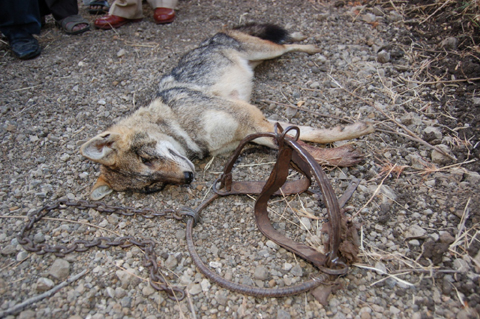
(picture by vishal bansod)
|
Story Of The Month
By Debashis Ray
It was a cold and windy day. The wind was riffling the water of the small pond near my home in Andal, each gust sending waves across the water in successive dark bands. It had pushed the floating water hyacinth piling to the opposite bank. Only the lily pads
and the thicket of ipomeas on the far side remained firmly rooted.
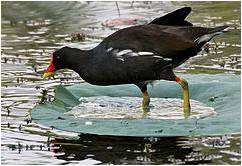
Photo courtesy GM Garg, Wikimedia Commons
Most of the birds who normally came to this marshy pool had sought shelter. But not all; near the lily pads swimming like ducks, were a pair of dark birds, the size of half-grown chickens. They had red yellow beaks and some light spots on their flanks-Indian
Moorhens. They were not alone. Swimming on the water between the adults were two little black balls-chicks in down.
The chicks were the size and color of squash balls, hardly able to keep up with their solicitous parents protecting and guiding their every move. The chicks probably were only one or two days old. The little family was swimming between the lilies and hyacinths,
when one adult bird skittered over the water and dived, only to emerge a few metres ahead. The second adult gave a sharp ‘Keank!’ call and frantically tried to chivvy the chicks towards the hyacinths.
A large kite like bird had just sailed over the little pond. Sitting with my back propped against a gnarled old tamarind tree next to the pond I had not seen its approach.
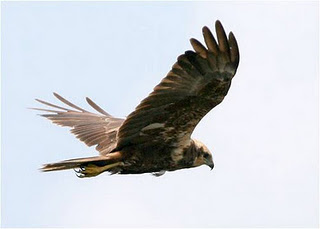
Photo courtesy Lip Kee, Flickr
This predator was brown all over like a pariah kite, but with a long rounded tail. It had a pale yellow cap and light colored patches on the leading edge of the wings. The legs were thin and long. It was a female Marsh Harrier seeking prey.
The harrier hovered five metres above the chicks, as the mother (?) bobbing her head tried to drive the chicks to safety of the water hyacinths. Out of fear or because they were naïve the chicks swam, but towards the lily pads. The harrier dropped a metre still
hovering, its long legs dangling. The hen dived again but came up immediately renewing her effort to protect her chicks. All the while the other adult kept swimming agitatedly but keeping his (?) distance.
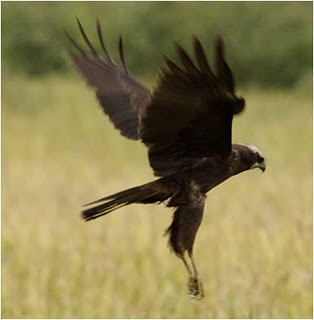
Photo courtesy Mohanram Kemparaju, Wikimedia Commons
The harrier flapping in the wind slowed and dropped another metre. The hen squawked in fright, dived and came up the next moment, a metre from her chicks. Now the harrier came down then rose, and one foot clutching a downy black ball, banked and sailed away
with the wind.
|
Wildlife Photolog
By Ajay Jain
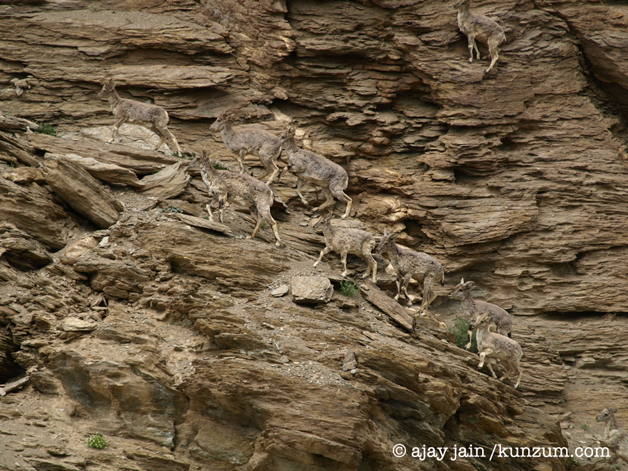
Tibetan Argalis in the Changthang Eco Zone in Ladakh
As you drive towards Pangong Tso and Tso Moriri, you enter the Changthang Eco Zone. It is an extension of Changthang, the Northern Tibetan Plateau, and covers about 15,000 square km (5,800 square miles). The elevation varies from 13,000 – 23,000 feet (about
4,000 – 7,000 metres) and the region is dotted by wide valleys amidst rolling hills and the occasional mountain lake. It is a cold desert that gets very little rainfall and very high solar radiation. Summer temperatures range from 0°C to 30°C (32 – 86 degrees
Fahreinheit) but the winter is hostile, with the land freezing over at -20°C to -40°C (68 – 104 degrees below zero Fahreinheit).
The region is strikingly beautiful but very desolate too. You wouldn’t want to be stranded here. There are few permanent human settlements. Much of the population are the nomadic Changpas who pitch tents wherever their livestock find pastures. In Changthang’s
wetlands live many vulnerable and endangered animals such as the Kiang (Tibetan Wild Ass), Tibetan Argali, Blue Sheep, Snow Leopard, Tibetan Wolf and Lynx. They are the only breeding site for the Bar-Headed Geese in India, and the only region outside China
where the highly endangered Black -Necked Cranes breed. Of course, you’ll need a lot of perseverance to spot these creatures.
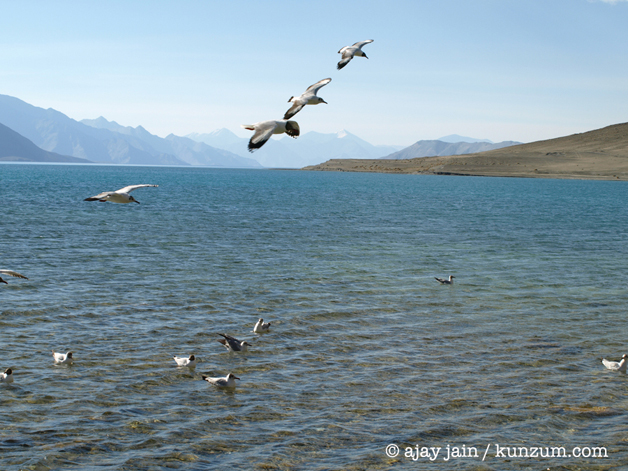
Brown-Headed Gulls flying over the Pangong Tso evoking images of Jonathan Livingstone Seagull
As you descend the 5360 m (17,586 feet) high Chang La (Pass) to get to Pangong Tso (Lake), you see a sign at Durbuk: ‘Welcome to the land of beautiful mountains and blue water lake.’ More signs await you. On a rocky patch, there’s another, ‘Ice hockey, the
sport of Eastern Ladakh, promoted by Army.’ The area is also the world’s highest army habitat it seems; only the sign reads ‘Arty Habitat.’ Creative, eh? I also met Kunchuk, 9, starting his 5 km walk to school, being seen off by his mother, grandfather and
baby brother Phunsuk. The family subsists on a meagre agricultural income but they are always smiling, and Kunchuk just loves going to school.
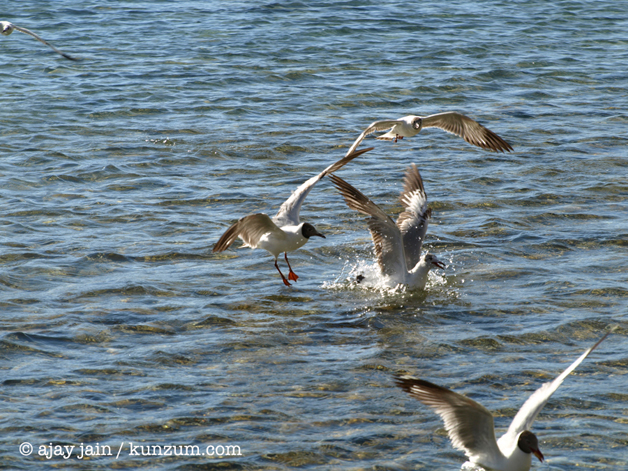
Brown-Headed Gulls frolicking in the Pangong Tso (Lake)
A little further on a rough strip of road, my car tyre ripped. And I still had the infamous Pagal Nala (‘mad stream’) to negotiate. It’s slippery and treacherous; you have to drive across it on tenterhooks. One wrong move and you’ll need a crane to pull you
out. In the middle of nowhere. Cross it before noon because the sun melts the ice later in the day and the slush is hell to drive on. But I made it. And just the first view of the gorgeous glacial lake was more than worth it.
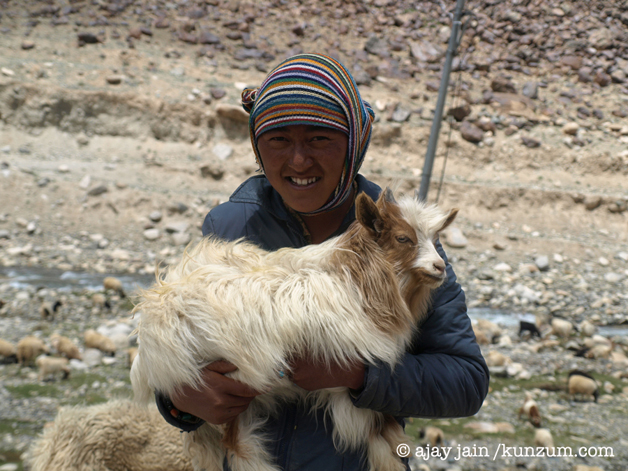
A young nomadic Changpa girl near Pangong Tso
The Perfect Blue
An endless blue awaits guarded by mountains on either side. The welcome party comprises Brownheaded Gulls, the Larus Brunnicephalus, hovering about on the most exquisite lake you would have ever seen. Just throw a few bread crumbs or biscuit bits and dozens
more gulls will materialise like magic. Every bit of biscuit I threw in evoked a flurry of flapping, waddling, jostling and even pecking to get to the ‘worm.’ Those flying overhead would swoop in and add to the commotion. And yet, some others would just wade
about with the peaceful countenance of the Buddha. Evolved sense of dignity or just full tummies?
The gulls in flight conjure up images of Jonathan Livingstone Seagull. This species flies pretty low over the water in direct purposeful flight, with low wing beat and frequent gliding. They might go for the occasional biscuit but their regular diet is much
healthier, comprising fish, insects, slugs and green shoots. You find these gulls at Tso Moriri and Tso Kar too in the summer, and westwards along the Indus valley during their spring and autumn migrations.
Playing with Himalayan Marmots
On the way back, keep an eye out for Himalayan Marmots, just the pets to cuddle up with in Ladakh’s sub-zero climes. These cousins of squirrels flee at the slightest hint of humans. But a ‘greedy’ group is always willing to throw caution to the winds – in return
for a treat of bananas and nuts. Tummies filled, they were quite friendly and snuggled up to my legs. They were also rather romantic and much Marmot-mushiness ensued. For six months starting October, Marmots hibernate. Huddled together in hay-covered burrows,
they halve their 8 kg body weight in this period. If only weight loss was so easy for all of us.
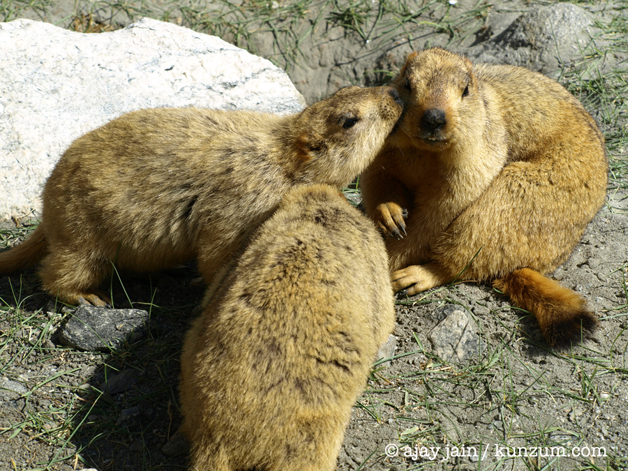
Himalayan Marmots in a romantic mood near the Pangong Tso (Lake)
(Ajay Jain is a travel writer and photographer and shares his stories on www.kunzum.com. He can be contacted at ajay@ajayjain.com)
|